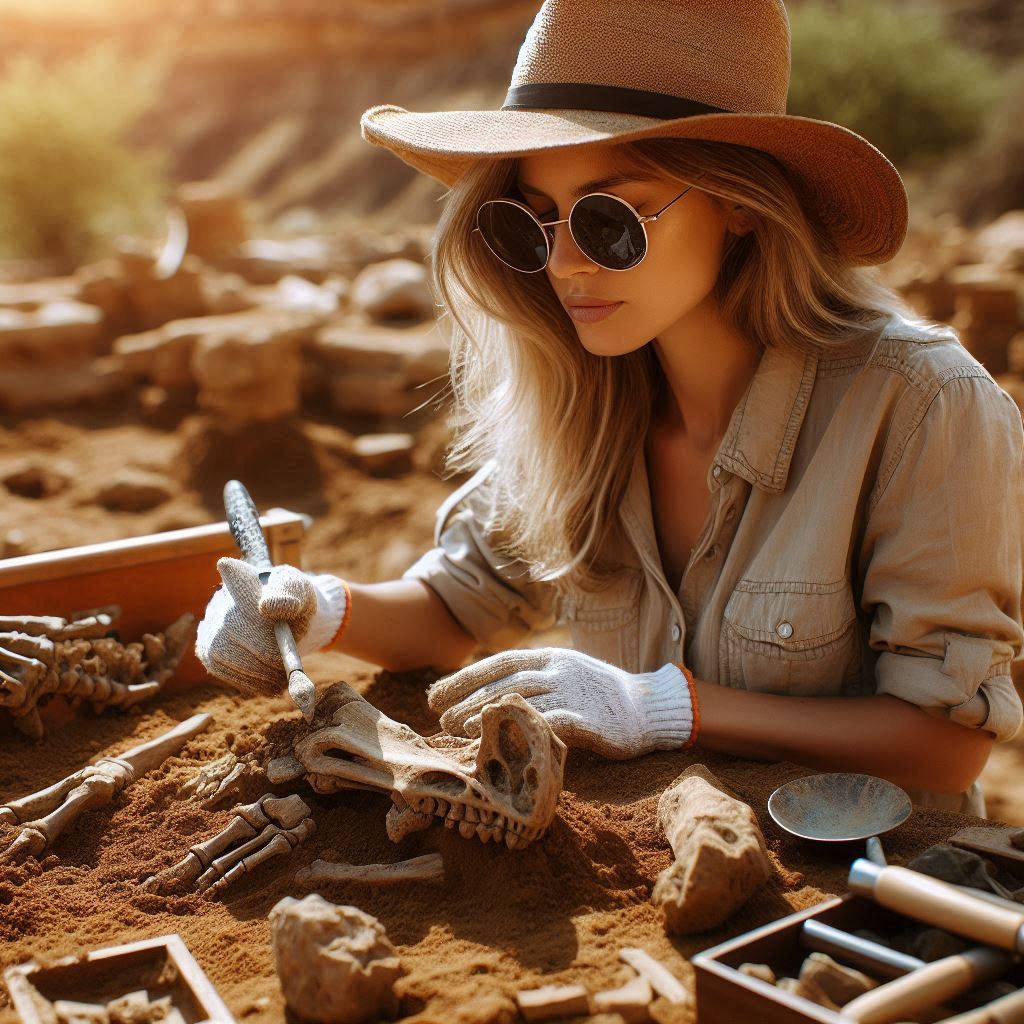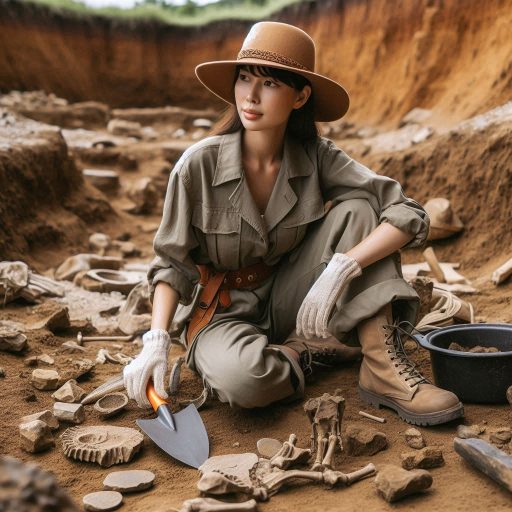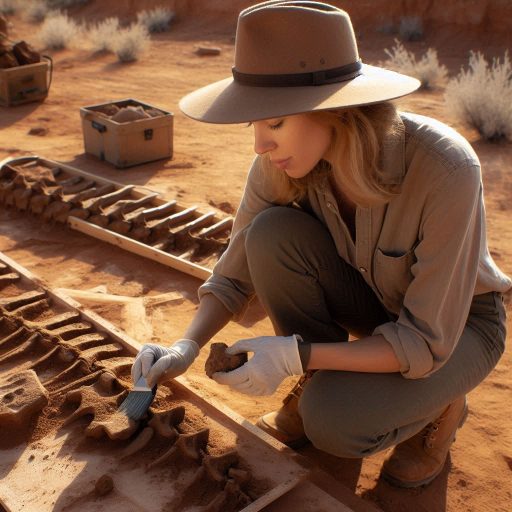Introduction
Archaeology is the study of human history through the excavation and analysis of artifacts, structures, and other material remains.
It combines elements of history, anthropology, and geology to uncover the stories of past civilizations.
Archaeologists work meticulously to understand how people lived, what they valued, and how their cultures evolved over time.
The importance of archaeologists in studying and preserving history cannot be overstated.
They play a crucial role in uncovering the layers of human experience that might otherwise be lost to time.
By examining tools, pottery, and architecture, archaeologists provide invaluable insights into ancient societies, their practices, and their interactions with the environment.
Their work not only helps to reconstruct historical narratives but also highlights the significance of cultural heritage.
In a rapidly changing world, where many archaeological sites face threats from urban development and climate change, archaeologists serve as guardians of history.
They advocate for the protection and preservation of these sites, ensuring that future generations can learn from and appreciate the rich tapestry of human experience.
Ultimately, archaeology helps us understand our past, informing our present and shaping our future.
Education and Training
The Typical Educational Background Required to Become an Archaeologist
Becoming an archaeologist requires a solid educational foundation and specialized training.
Most archaeologists hold a bachelor‘s degree in archaeology, anthropology, or a related field.
Many universities offer degree programs specifically in archaeology, providing essential knowledge about human history and culture.
Courses often cover topics such as excavation techniques, artifact analysis, and ancient civilizations.
After earning a bachelor’s degree, many aspiring archaeologists pursue a master‘s degree.
A master’s degree allows students to specialize in a particular area of archaeology.
Specializations can include historical archaeology, underwater archaeology, or paleoanthropology.
This advanced education enhances their research skills and theoretical knowledge, preparing them for fieldwork.
Some archaeologists choose to continue their education with a Ph.D.
This level of education is essential for those who wish to teach at the university level or lead major research projects.
A Ph.D. program involves conducting original research and producing a dissertation.
This research contributes to the field‘s knowledge base and helps establish the archaeologist‘s expertise.
The Necessary Skills and Training Needed for This Profession
In addition to formal education, practical experience is vital for success in archaeology.
Many degree programs include field schools, where students gain hands-on experience.
Field schools allow students to participate in excavations, learn site documentation, and practice artifact recovery.
This experience is invaluable, as it helps students develop practical skills and a deeper understanding of archaeological methods.
Skills are also crucial for an archaeologist.
Strong analytical abilities enable archaeologists to interpret data and artifacts effectively.
They must be detail-oriented, as even small findings can provide significant insights.
Excellent problem-solving skills help archaeologists navigate challenges encountered during fieldwork.
Communication skills are equally important.
Archaeologists must collaborate with other team members and share findings with the public.
Writing skills are essential for preparing reports and publishing research.
Many archaeologists also engage with communities, explaining their work and findings to the public.
Technical skills are increasingly important in archaeology.
Familiarity with Geographic Information Systems (GIS) enhances data analysis and mapping capabilities.
Proficiency in various excavation tools and laboratory equipment is also necessary.
Some archaeologists specialize in using remote sensing technologies to locate sites without excavation.
Continuing education and professional development are vital for archaeologists.
Workshops, conferences, and courses help them stay updated on the latest techniques and theories.
Networking with other professionals also opens doors for collaboration and research opportunities.
In summary, a career in archaeology requires a strong educational background and a diverse skill set.
From formal degrees to practical experience, aspiring archaeologists must be well-prepared for this rewarding field.
With dedication and passion, they can uncover the secrets of the past and contribute to our understanding of human history.
Fieldwork
The Process of Conducting Fieldwork as an Archaeologist
Fieldwork is a fundamental aspect of archaeology, allowing researchers to uncover artifacts and gather data about past human behaviors.
The process typically begins with thorough research to identify potential excavation sites.
Archaeologists study historical records, maps, and previous research to determine areas of interest.
Once a site is chosen, they obtain necessary permits and permissions from relevant authorities.
After securing the site, archaeologists conduct preliminary surveys.
These surveys help assess the area‘s potential for significant findings.
They use various methods, such as surface surveys and geophysical techniques, to identify promising locations.
Surface surveys involve walking the site and documenting visible artifacts, while geophysical techniques utilize tools to detect buried structures or anomalies without excavation.
Once the site is deemed worthy of excavation, archaeologists prepare a detailed excavation plan.
This plan outlines the goals, methodology, and timeline for the excavation process.
The team usually includes archaeologists, students, and volunteers, all trained in excavation techniques.
During excavation, archaeologists carefully remove soil layers to uncover artifacts.
They work in grids or squares, ensuring that each layer is recorded meticulously.
Each layer‘s depth and contents are documented, as this stratigraphy provides vital information about the site‘s history.
Excavation is often slow and deliberate, with archaeologists using tools like trowels, brushes, and shovels to expose artifacts without causing damage.
The Tools and Techniques Used During Excavations and Surveys
The tools used in archaeology are essential for conducting fieldwork effectively.
Standard excavation tools include trowels, shovels, brushes, and hand picks.
Trowels are particularly important for precise digging, while brushes help clean artifacts and delicate features.
Archaeologists also use measuring tools, such as tape measures and laser rangefinders, to ensure accurate documentation of the excavation site.
Recording equipment, like cameras and notebooks, captures visual and written records of the findings.
These records are crucial for later analysis and reporting.
In addition to basic tools, modern technology plays a significant role in archaeology.
Geographic Information Systems (GIS) are widely used for mapping sites and analyzing spatial relationships.
This technology helps archaeologists visualize the data collected during surveys and excavations.
Geophysical survey techniques, such as ground-penetrating radar (GPR) and resistivity surveys, allow archaeologists to detect subsurface features without disturbing the ground.
These methods help identify structures like walls, roads, or burial sites before excavation begins.
When excavating, archaeologists employ stratigraphic excavation techniques.
They carefully remove soil in layers, documenting the context of each artifact found.
This method preserves the relationship between artifacts and their surrounding materials, providing insights into their use and significance.
After excavation, archaeologists analyze the collected artifacts and data.
They clean, catalog, and store artifacts for further study.
This analysis helps reconstruct past societies and understand their cultural practices.
Fieldwork is a crucial part of an archaeologist‘s role.
From site selection to excavation and analysis, each step is essential for uncovering the past.
By employing a combination of traditional tools and modern technology, archaeologists can gain valuable insights into human history.
Read: Interdisciplinary Research: Botany and Other Sciences
Analysis and Interpretation
How Archaeologists Analyze and Interpret the Artifacts and Data They Uncover
After conducting fieldwork and collecting artifacts, archaeologists begin the process of analysis and interpretation.
This stage is crucial for understanding the historical context and cultural significance of the findings.
The analysis process typically starts with cleaning and cataloging the artifacts.
Each item is meticulously recorded, including its location, depth, and surrounding materials.
This information provides valuable context for further analysis.
Next, archaeologists employ various methods to analyze artifacts.
They examine their physical characteristics, such as material composition, size, shape, and manufacturing techniques.
For example, pottery fragments may be analyzed for decoration styles, firing techniques, or use-wear patterns, which can reveal information about the people who created and used them.
Dating techniques, such as radiocarbon dating or dendrochronology, help establish a timeline for the artifacts.
These methods allow archaeologists to determine when the items were made or used, providing insight into the chronological development of the site.
Understanding the timeline is essential for reconstructing past human activities and societal changes.
In addition to analyzing individual artifacts, archaeologists look at the larger patterns revealed by the data.
They study the spatial relationships between artifacts, considering how items were distributed within the site.
This spatial analysis can indicate patterns of human behavior, such as trade routes, social structures, or settlement patterns.
Archaeologists also utilize various software tools for data analysis.
These tools assist in organizing, visualizing, and interpreting complex datasets.
For instance, Geographic Information Systems (GIS) help archaeologists create maps and analyze spatial relationships within the archaeological site.
The Importance of Collaboration with Other Professionals in the Field
Collaboration is vital in archaeology, as it brings together diverse expertise to enhance the interpretation of findings.
Archaeologists often work alongside specialists in various fields, such as historians, geologists, botanists, and zoologists.
Each specialist contributes unique knowledge that enriches the overall understanding of the archaeological record.
For example, a botanist can analyze plant remains to provide insights into ancient diets and agricultural practices.
Similarly, a zoologist can study animal bones to shed light on hunting practices and animal domestication.
These interdisciplinary collaborations help create a more comprehensive picture of past societies.
Moreover, collaboration extends beyond the academic realm.
Archaeologists often engage with local communities and indigenous groups when analyzing findings.
These groups can provide invaluable context and cultural knowledge, enriching the interpretation of artifacts.
Engaging with local stakeholders fosters mutual respect and encourages ethical practices in archaeology.
Professional conferences and workshops also play a significant role in collaboration.
These events allow archaeologists to share research findings, discuss methodologies, and explore new ideas.
Networking with other professionals helps archaeologists stay updated on the latest advancements and fosters potential partnerships.
Analysis and interpretation are critical stages in archaeology that require careful examination of artifacts and data.
By employing a combination of analytical methods and collaborative efforts, archaeologists can uncover the stories behind the artifacts they discover.
This collaborative approach not only enriches the research but also enhances the understanding of past human societies and their cultural heritage.
Read: Women in Botany: Celebrating Pioneers and Leaders

Reporting and Documentation in Archaeology
The Process of Documenting Findings and Creating Reports
The process of documenting findings and creating reports is a critical aspect of archaeology.
After completing fieldwork and analysis, archaeologists compile comprehensive documentation of their discoveries.
This process typically begins with organizing and cataloging artifacts, features, and other data collected during excavations.
Archaeologists create detailed records for each artifact, including descriptions, measurements, photographs, and provenance information.
They also document the context in which artifacts were found, noting their spatial relationships and stratigraphy.
This contextual information is vital for understanding the significance of the findings.
Following the cataloging stage, archaeologists synthesize their observations into a formal report.
The report typically includes several key components:
- Introduction: This section provides background information on the project, including the site‘s location, purpose, and research questions.
- Methodology: Here, archaeologists describe the techniques used during fieldwork and analysis.
They detail excavation methods, survey techniques, and any laboratory analyses performed. - Findings: This section presents the results of the excavation, including a summary of artifacts, features, and other significant discoveries.
Visual aids like maps, tables, and photographs help illustrate the findings. - Discussion: In this part, archaeologists interpret the findings and connect them to broader historical or cultural contexts.
They explore the implications of the discoveries and how they contribute to existing knowledge in the field. - Conclusion: The report wraps up by summarizing the key findings and suggesting areas for future research.
- References: This section lists all sources cited in the report, including academic literature and historical documents.
Once completed, the report is shared with relevant stakeholders, including funding agencies, local authorities, and academic institutions.
Archaeologists may also publish their findings in academic journals, presenting their work to the broader academic community.
The Role of Archaeologists in Sharing Discoveries with the Public and Academic Community
Archaeologists play a vital role in sharing their discoveries with both the public and the academic community.
Effective communication of findings ensures that the knowledge gained from archaeological research reaches a wider audience.
To engage the public, archaeologists often participate in outreach programs and educational initiatives.
They may host public lectures, workshops, and site tours, inviting community members to learn about archaeology and the significance of local discoveries.
These outreach efforts help foster an appreciation for cultural heritage and promote understanding of the archaeological process.
Publications, such as popular articles and books, are another avenue for sharing discoveries.
By writing for non-academic audiences, archaeologists can convey complex ideas in accessible language.
This helps demystify archaeology and encourages public interest in historical research.
Collaboration with museums and cultural institutions also enhances public engagement.
Archaeologists often work with curators to develop exhibits that showcase artifacts and share the stories behind them.
These exhibits can educate visitors about ancient cultures and the methods used to uncover their histories.
In the academic realm, archaeologists contribute to scholarly discourse by publishing their research in peer-reviewed journals.
These publications allow them to share findings with other professionals in the field, fostering collaboration and ongoing research.
Conferences and symposia also provide platforms for archaeologists to present their work, discuss methodologies, and exchange ideas with colleagues.
The reporting and documentation process is essential for preserving archaeological findings and sharing them with diverse audiences.
By effectively communicating their discoveries, archaeologists contribute to the public’s understanding of history and foster appreciation for cultural heritage.
Through collaboration with the academic community and public engagement, they ensure that the knowledge gained from their work is accessible and impactful.
Read: How Climate Change Is Impacting Plant Research
Challenges and Rewards
The Challenges That Archaeologists Face in Their Work
Archaeologists encounter several challenges in their work, impacting their ability to conduct research and preserve cultural heritage.
One of the primary challenges is funding.
Many archaeological projects rely on grants and donations to support fieldwork and analysis.
Securing sufficient funding can be difficult, leading to project delays or cancellations.
Limited budgets may restrict the scope of research, making it challenging to explore significant sites fully.
Ethical issues also pose a significant challenge for archaeologists.
They must navigate complex ethical considerations regarding site preservation, artifact ownership, and community involvement.
For instance, excavating sites without proper permissions can lead to conflicts with local communities and governments.
Moreover, questions surrounding the ownership of artifacts found in excavations can create tensions between archaeologists and indigenous groups or local stakeholders.
Ethical dilemmas arise when balancing the pursuit of knowledge with respecting cultural heritage and community rights.
Environmental factors can complicate archaeological work as well.
Natural disasters, climate change, and urban development can threaten archaeological sites.
For example, rising sea levels can inundate coastal sites, while construction projects may inadvertently destroy important historical locations.
Archaeologists often find themselves racing against time to document and excavate sites before they are lost forever.
Another challenge lies in the need for interdisciplinary collaboration.
Archaeology often intersects with various fields, including history, anthropology, and geology.
Coordinating efforts among diverse experts can be difficult, especially when aligning methodologies and research objectives.
The Rewards of Being an Archaeologist
Despite the challenges, the rewards of being an archaeologist are significant and fulfilling.
One of the primary rewards is the opportunity to contribute to historical knowledge.
Archaeologists uncover artifacts, structures, and features that shed light on past human behaviors and societies.
By analyzing these findings, they help reconstruct historical narratives, deepening our understanding of human history.
The thrill of discovery is another compelling aspect of archaeology.
Unearthing artifacts and sites provides a sense of connection to the past.
Each excavation brings the potential for new insights, whether it‘s a unique pottery shard, a burial site, or ancient tools.
These discoveries often inspire excitement and curiosity, motivating archaeologists to continue their work.
Preserving cultural heritage is also a rewarding aspect of the profession.
Archaeologists play a crucial role in protecting and conserving archaeological sites and artifacts.
Their efforts ensure that future generations can appreciate and learn from the past.
This commitment to preservation fosters a sense of responsibility and purpose, making their work meaningful.
Additionally, archaeologists often engage with local communities and indigenous groups.
This collaboration enriches their research and helps build trust between archaeologists and the communities they study.
Contributing to community heritage and education can be immensely rewarding, as it promotes cultural pride and understanding.
Lastly, the field of archaeology offers opportunities for personal and professional growth.
Archaeologists continuously learn and develop new skills, from field techniques to advanced analytical methods.
They also engage in ongoing education, attending conferences and workshops to stay current in their field.
This commitment to learning fosters a dynamic and evolving career.
While archaeologists face challenges such as funding issues and ethical dilemmas, the rewards of their work are profound.
Their contributions to historical knowledge and cultural preservation make a lasting impact, ensuring that the stories of past societies continue to resonate with future generations.
The thrill of discovery and the opportunity to engage with communities further enhance the fulfilling nature of the profession.
Read: Exploring the Different Branches of Geology
Find Out More: Soil Scientist Internship and Training Programs
Career Opportunities
The Various Career Paths Available to Archaeologists
Archaeology offers a diverse range of career paths, allowing professionals to pursue their interests in various sectors.
One of the most common career routes is academia.
Many archaeologists work as professors or researchers at universities, teaching students and conducting original research.
Academic positions often provide opportunities for publishing research findings and securing grants for further studies.
Another prominent career path is cultural resource management (CRM).
CRM professionals work to preserve archaeological sites and artifacts, particularly in the context of construction projects or land development.
They assess the potential impact of projects on archaeological resources and develop plans for site preservation.
Many archaeologists find CRM work rewarding, as it combines fieldwork with advocacy for cultural heritage.
Some archaeologists work in museums, where they curate collections, develop exhibitions, and engage in public education.
Museum professionals often collaborate with researchers and local communities to create meaningful exhibits that highlight cultural heritage.
This career path allows archaeologists to share their findings with the public and promote appreciation for history.
Government agencies also employ archaeologists in various capacities.
For example, archaeologists may work for federal or state agencies, conducting assessments and ensuring compliance with heritage preservation laws.
These roles can involve fieldwork, research, and policy development, making them vital for protecting cultural resources.
Additionally, some archaeologists may choose to work in the private sector, providing consulting services for companies involved in land development, construction, or environmental assessments.
These professionals help clients navigate regulatory requirements and ensure that archaeological considerations are integrated into project planning.
The Job Outlook and Potential for Advancement in the Field
The job outlook for archaeologists can vary depending on the specific career path and location.
According to the U.S. Bureau of Labor Statistics, employment for anthropologists and archaeologists is projected to grow by 5% from 2021 to 2031, which is about average compared to other professions.
This growth is influenced by an increasing awareness of the importance of cultural heritage and the need for compliance with regulations protecting archaeological sites.
In cultural resource management, job prospects are particularly strong.
As urban development and infrastructure projects continue to expand, the demand for professionals who can assess and manage archaeological resources is likely to rise.
Additionally, the need for compliance with environmental regulations ensures ongoing opportunities for archaeologists in government and consulting roles.
Advancement in the field of archaeology often depends on education, experience, and networking.
Many archaeologists pursue advanced degrees, such as master’s or Ph.D. programs, to enhance their qualifications and broaden their career prospects.
Advanced degrees can lead to leadership positions in academia, research, or cultural resource management.
Networking and professional development are also crucial for career advancement.
Attending conferences, joining professional organizations, and collaborating with colleagues can open doors to new opportunities.
As archaeologists build their reputations in the field, they may have the chance to lead research projects, secure grants, and mentor emerging professionals.
In essence, archaeology offers a variety of career paths, including academia, cultural resource management, museum work, and government positions.
The job outlook is generally positive, with strong demand in CRM and related fields.
Advancement opportunities exist through education, experience, and networking, allowing archaeologists to pursue fulfilling and impactful careers in preserving cultural heritage and expanding historical knowledge.
Explore Further: Best Programming Languages for Data Science
Transform Your Career Today
Unlock a personalized career strategy that drives real results. Get tailored advice and a roadmap designed just for you.
Start NowConclusion
Archaeologists play a vital role in uncovering and preserving our past.
Their work goes beyond just digging; it involves a variety of tasks that help us understand human history.
They conduct meticulous fieldwork, analyzing artifacts, and interpreting the historical contexts surrounding their discoveries.
Each excavation reveals valuable insights into ancient civilizations, shedding light on how people lived, worked, and interacted.
This profession requires a unique blend of skills, including research, critical thinking, and teamwork.
Archaeologists must be detail-oriented and passionate about history to succeed in their field.
They often collaborate with other experts, such as historians and conservators, to piece together the narratives of our ancestors.
Their contributions help us understand human behavior and cultural development throughout the ages.
For those fascinated by history and discovery, archaeology offers a rewarding career path.
It allows individuals to connect with humanity’s journey through time and make a meaningful impact on society.
Aspiring archaeologists should explore educational programs and gain hands-on experience in the field.
Volunteering on digs or participating in internships can provide valuable exposure to the profession and help build essential skills.
Encouraging curiosity about the past fosters a deeper appreciation for our shared heritage.
By learning more about archaeology, you can contribute to preserving history and expanding our knowledge.
This field also plays a crucial role in cultural preservation, helping protect sites that may be threatened by development or climate change.
[E-Books for Sale]
The Big Book of 500 High-Paying Jobs in America: Unlock Your Earning Potential
$19.99 • 500 High-Paying Jobs • 330 pages
Explore 500 high-paying jobs in America and learn how to boost your career, earn more, and achieve success!
See All 500 High-Paying Jobs of this E-Book
1001 Professions Without a Degree: High-Paying American Jobs You Can Start Now
$19.99 • 1001 Professions Without a Degree • 174 pages
Discover 1001 high-paying jobs without a degree! Unlock career tips, skills, and success strategies for just $19.99!




